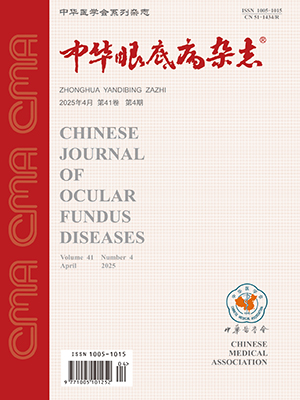| 1. |
Yannuzzi LA, Sorenson J, Spaide RF, et al. Idiopathic polypoidal choroidal vasculopathy (IPCV)[J]. Retina, 2013, 32 Suppl 1: S1-8.
|
| 2. |
Koh A, Lee WK, Chen LJ, et al. Everest study: efficacy and safety of verteporfin photodynamic therapy in combination with ranibizumab or alone versus ranibizumab monotherapy in patients with symptomatic macular polypoidal choroidal vasculopathy[J]. Retina, 2012, 32(8): 1453-1464. DOI: 10.1097/IAE.0b013e31824f91e8.
|
| 3. |
Gomi F, Oshima Y, Mori R, et al. Initial versus delayed photodynamic therapy in combination with ranibizumab for treatment of polypoidal choroidal vasculopathy: the Fujisan study[J]. Retina, 2015, 35(8): 1569-1576. DOI: 10.1097/IAE.0000000000000526.
|
| 4. |
Yannuzzi LA, Wong DW, Sforzolini BS, et al. Polypoidal choroidal vasculopathy and neovascularized age-related macular degeneration[J]. Arch Ophthalmol, 1999, 117: 1503-1510. DOI: 10.1001/archopht.117.11.1503.
|
| 5. |
Guyer DR, Yannuzzi LA, Slankter JS, et al. Digital indocyanine green videoangiography of central serous chorioretinopathy[J]. Arch Ophthalmol, 1994, 112(8): 1057-1062. DOI: 10.1001/archopht.1994.01090200063023.
|
| 6. |
Spaide RF, Hall L, Haas A, et al. Indocyanine green videoangiography of older patients with central serous chorioretinopathy[J]. Retina, 1996, 16(3): 203-213. DOI: 10.1097/00006982-199616030-00004.
|
| 7. |
马楠, 陈有信, 巩迪, 等. 息肉样脉络膜血管病变吲哚青绿血管造影与光相干断层扫描血管成像图像特征对比观察[J]. 中华眼底病杂志, 2015, 31(5): 421-424. DOI: 10.3760/cma.j.issn.1005-1015.2015.05.003.Ma N, Chen YX, Gong D, et al. Comparative observation of indocyanine green angiography and optical coherence tomography angiography in polypoidal choroidal vasculopathy[J]. Chin J Ocul Fundus Dis, 2015, 31(5): 421-424. DOI: 10.3760/cma.j.issn.1005-1015.2015.05.003.
|
| 8. |
Koizumi H, Yamagishi T, Yamazaki T, et al. Subfoveal choroidal thickness in typical age-related macular degeneration and polypoidal choroidal vasculopathy[J]. Graefe’s Arch Clin Exp Ophthalmol, 2011, 249(8): 1123-1128. DOI: 10.1007/s00417-011-1620-1.
|
| 9. |
Chung SE, Kang SW, Lee JH, et al. Choroidal thickness in polypoidal choroidal vasculopathy and exudative age-related macular degeneration[J]. Ophthalmology, 2010, 118(5): 840-845. DOI: 10.1016/j.ophtha.2010.09.012.
|
| 10. |
Kim SW, Oh J, Kwon SS, et al. Comparison of choroidal thickness among patients with healthy eyes, early age-related macular degeneration, central serous chorioretinopathy and polypoidal vasculopathy[J]. Retina, 2011, 31(9): 1904-1911. DOI: 10.1097/IAE.0b013e31821801c5.
|
| 11. |
Spaide RF, Yannuzzi LA, Slakter JS, et al. Indocyanine green videoangiography of idiopathic polypoidal choroidal vasculopathy[J]. Retina, 1995, l5(2): 100-110. DOI: 10.1097/00006982-199616030-00004.
|
| 12. |
Maruko I, Iida T, Oyamada H, et al. Choroidal thickness changes after intravitreal ranibizumab and photodynamic therapy in recurrent polypoidal choroidal vasculopathy[J]. Am J Ophthalmol, 2013, 156(3): 548-556. DOI: 10.1016/j.ajo.2013.03.041.
|
| 13. |
Maruko I, Iida T, Sugano Y, et al. Subfoveal choroidal thickness after treatment of central serous chorioretinopathy[J]. Ophthalmology, 2010, 1179(9): 1792-1799. DOI: 10.1016/j.ophtha.2010.01.023.
|
| 14. |
Ting DS, Ng WY, Ng SR, et al. Choroidal thickness changes in age-related macular degeneration and polypoidal choroidal vasculopathy: a 12-month prospective study[J]. Am J Ophthalmol, 2016, 164: 128-136. DOI: 10.1016/j.ajo.2015.12.024.
|
| 15. |
Alshareef RA, Khuthaila MK, Januwada M, et al. Choroidal vascular analysis in myopic eyes: evidence of foveal medium vessel layer thinning[J/OL]. Int J Retina Vitreous, 2017, 3: 28[2017-05-26]. https://pubmed.ncbi.nlm.nih.gov/28560051/. DOI: 10.1186/s40942-017-0081-z.
|
| 16. |
Tong JP, Chan WM, Liu DT, et al. Aqueous humor levels of vascular endothelial growth factor and pigment epithelium-derived factor in polypoidal choroidal vasculopathy and choroidal neovascularization[J]. Am J Ophthalmol, 2006, 141(3): 456-462. DOI: 10.1016/j.ajo.2005.10.012.
|
| 17. |
Matsuoka M, Ogata N, Otsuji T, et al. Expression of pigment epithelium derived factor and vascular endothelial growth factor in choroidal neovascular membranes and polypoidal choroidal vasculopathy[J]. Br J Ophthalmol, 2004, 88(6): 809-815. DOI: 10.1136/bjo.2003.032466.
|
| 18. |
Lee WK, Baek J, Dansingani KK, et al. Choroidal morphology in eyes with polypoidal choroidal vasculopathy and normal or subnormal subfoveal choroidal thickness[J]. Retina, 2016, 368(Suppl 1): S73-82. DOI: 10.1097/IAE.0000000000001346.
|
| 19. |
何吕福, 王晓华, 温旭. 脉络膜厚度研究进展[J]. 中华实验眼科杂志, 2017, 35(10): 949-954. DOI: 10.3760/cma.j.issn.2095-0160.2017.10.021.He LF, Wang XH, Wen X. Review on progress of choroidal thickness[J]. Chin J Exp Ophthalmol, 2017, 35(10): 949-954. DOI: 10.3760/cma.j.issn.2095-0160.2017.10.021.
|
| 20. |
Kawamura A, Yuzawa M, Mori R, et al. Indocyanine green angiographic and optical coherence tomographic findings support classification of polypoidal choroidal vasculopathy into two types[J]. Acta Ophthalmol, 2013, 91(6): 474-481. DOI: 10.1111/aos.12110.
|
| 21. |
Warrow DJ, Hoang QV, Freund KB. Pachychoroid pigment epitheliopathy[J]. Retina, 2013, 33(8): 1659-1672. DOI: 10.1097/IAE.0b013e3182953df4.
|
| 22. |
Moussa M, Sabry D, Soliman W. Macular choroidal thickness in normal Egyptians measured by swept source optical coherence tomography[J]. BMC Ophthalmol, 2016, 16: 138. DOI: 10.1186/s12886-016-0314-1.
|
| 23. |
Tan CS, Lim LW, Ngo WK, et al. Everest report 5: clinical outcomes and treatment response of polypoidal choroidal vasculopathy subtypes in a multicenter, randomized controlled trial[J]. Invest Ophthalmol Vis Sci, 2018, 59(2): 889-896. DOI: 10.1167/iovs.17-22683.
|
| 24. |
Koh AH, Chen LJ, Chen SJ, et al. Polypoidal choroidal vasculopathy: evidence-based guidelines for clinical diagnosis and treatment[J]. Retina, 2013, 33(4): 686-716. DOI: 10.1097/IAE.0b013e3182852446.
|
| 25. |
Koizumi H, Kano M, Yamamoto A, et al. Short-term changes in choroidal thickness after aflibercept therapy for neovascular age-related macular degeneration[J]. Am J Ophthalmol, 2015, 159(4): 627-633. DOI: 10.1016/j.ajo.2016.04.026.
|




